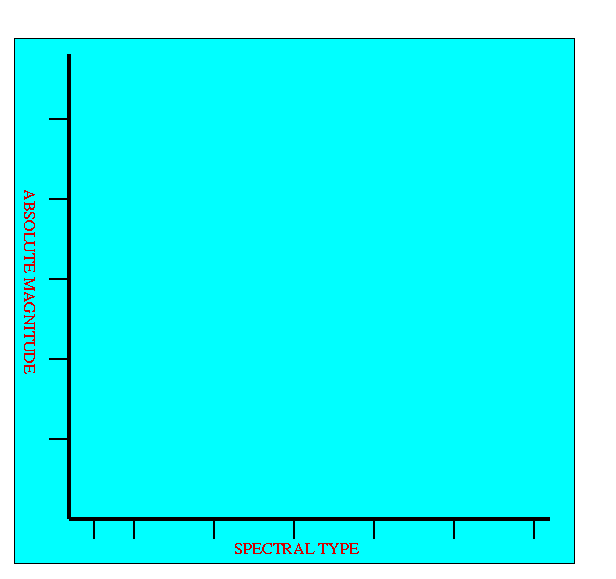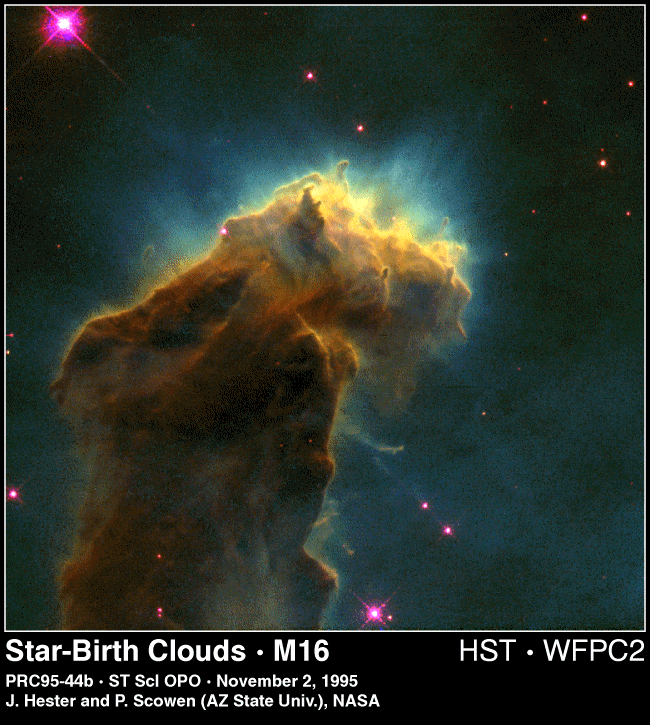Stars and Steller Evolution Lecture 12
Hertzsprung-Russell Diagram
In this lecture we presented the Hertzsprung-Russell Diagram (HR)
where we plot a star determined by it's spectral type (or Temperature)
and absolute magnitude. This diagram is rather central to the remaining
lectures and has to be seen!
It has several features

|
| Empty graph
|
| Add our sun
|
| and other stars
|
| main sequence stars
|
| Red Giant stars
|
| Red Supergiants stars
|
| Blue Giant stars
|
| White Dwarf stars
|
|
-
The obvious main feature is the Main Sequence of stars.
This includes the sun and many others. It covers a band from dull,
yellow stars right up to bright blue/white stars.
-
The grouping known as Supergiants containing Rigel and Deneb.
very bright stars - and yellow-red
- Red giants - a group of red bright stars, notably Betalgues,
Antares, Aldebaron.
- White Dwarves - stars on the ``blue side'' of main sequence.
Basically wimpish but white stars. Includes Sirius B.
Main Sequence Stars
Our sun is a main sequence star. We understand the sun and hence main
sequence stars reasonably well.
In the sun there are two opposing forces at work. Firstly there is
gravity - this force will always try to contract the star. Opposing
this force there is pressure from within. In the sun these two forces
is in stable equilibrium. The sun is almost entirely hydrogen and
helium. Since these, in the core, are very hot they produce a pressure
which balances the gravitational attraction. Changing the temperature
would change the balance. Since the Sun radiates heat something must
produce energy in the sun - otherwise it would cool. The ``powerhouse''
at the centre of the sun is thought to be nuclear fusion reactions. To
understand how the sun works we must understand nuclear fission and
fusion. The radius of the central core where fusion occurs is about
0.2 of the suns radius.
Nuclear Fusion and Fission
Nuclei (at the centre of atoms) are composed of protons and neutrons.
The lowest enegry nucleus is that of iron which consists of 56 protons
and neutrons. This allows us two possibilities,
- Breaking up a large nucleus (twice as big as iron say) into
two peices closer to iron plus energy. This is Nuclear Fission
- Taking two small nuclei and joining them together to make a larger
nucleus (closer to iron). This is Nuclear Fusion
- All current nuclear power station use fission - breaking up a very
large nucleus such as uranium.
- Nuclear weapons come in both varieties. Hiroshima/Nagasaki were
both
fission bombs. The more powerful hydrogen bombs use fusion
- Main sequence stars are powered by the reaction
4H -> He
That is joining together four hydrogen nuclei (via various intermediate
steps) to form a helium nucleus. (positrons and neutrinos are also
produced)
- Hydrogen nuclei (a single proton!) have positive electric charge.
Thus they naturaly repel. It is difficult to get the Hydrogens close
enough to ``stick''. This is why fusion power generation has so far
eluded us. It needs high ebnergies/pressures/temperatueres
to get the hydrogen close.
-
The intense pressures/temperatures at the suns core allow fusion to
occur.
The sun is a complicated object. It does not have a "hard" edge like
the earth but
has layers of increasing density/pressure.
- The core is where the fusion takes place temperature reach
14 million degrees,
- The remainder of the interior cobsists of Hydrogen/Helium but
pressure/temperature are not enough for fusion.
- there is a 200-300 km layer called the photosphere. Here the
temperature is around 6000C. This is where all the light that we see it
emmited. It is not a solid boundary but is an optical boundary
-we
cannot see through it.
- Above the photosphere is the Chromosphere, (transparent)
- Finally we have the Corona which is very hot but very dilute gas.
Visable during solar eclipses.
Some useful pictures of the sun are
Solar Model
Using nuclear (and other) physics we can build a model of the sun - and
by changing parameters models of other main sequence stars. We can
characterise the other sun by the total mass. A convenient use is solar
masses. 1 Ms = mass of sun = 1.99x 1030 kg =333,000 earth masses.
(I can't type the symbol for solar mass...). Using this we can build
models of how stars will function depending upon the initial mass.
| Mass | Surface T | Luminosity |
Lifetime ( million yrs) |
| 0.5 | 4000 | 0.03 |
200,000 |
0.75 | 5000 | 0.5 |
15,000 |
| 1 | 6000 | 1 |
10,000 |
| 1.5 | 7000 | 5 |
3,000 |
| 3 | 11,000 | 60 |
500 |
| 15 | 30,000 | 10,000 |
15 |
| 25 | 35,000 | 80,000 |
3 |
I have introduced a new concept - Luminosity . This is the energy
(
in light of its various forms) emitted by the star. I use units in terms
of the sun's
luminosity.
© Dave Dunbar 2020






